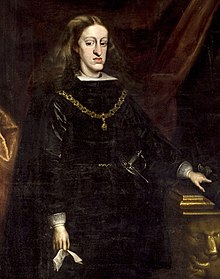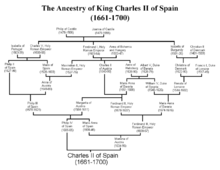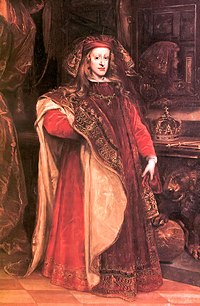User:LaNaranja/Sandbox/Carlos
| Charles II | |
|---|---|
 | |
| King of Spain | |
| Reign | 17 September 1665–1 November 1700 |
| Predecessor | Philip IV |
| Successor | Philip V |
| Burial | |
| Spouse | Marie Louise of Orléans (1679–1689) Maria Anna of Pfalz-Neuburg (1689–1700) |
| Father | Philip IV of Spain |
| Mother | Mariana of Austria |
Charles II (6 November 1661, Madrid – 1 November 1700, Madrid), was the last Habsburg King of Spain and the ruler of nearly all of Italy (except Piedmont, the Papal States and the Republic of Venice), the Spanish territories in the Southern Low Countries, and Spain's overseas Empire, stretching from Mexico to the Philippines. He is noted for his extensive physical, intellectual, and emotional problems – along with the consequent ineffectual rule – as well as his role in the developments preceding the War of Spanish Succession.
Ancestry[edit]
Charles was the only surviving son of his Habsburg predecessor, King Philip IV of Spain and his second Queen (and niece), Mariana of Austria, another Habsburg. His birth was greeted with joy by the Spaniards, who feared the disputed succession which could have ensued if Philip IV had left no male heir.

Seventeenth-century European noble culture commonly matched cousin to first cousin and uncle to niece, to preserve a prosperous family's properties. Charles's own immediate pedigree was exceptionally populated with nieces giving birth to children of their uncles: Charles's mother was niece of Charles's father, being daughter of Maria Anna of Spain (1606–46) and Emperor Ferdinand III. Thus, Empress Maria Anna was simultaneously his aunt and grandmother.[1] This inbreeding had given many in the family hereditary weaknesses. That Habsburg generation was more prone to still-births than were peasants in Spanish villages.[2] There was also insanity in Charles's family; his great-great-great(-great-great, depending along which lineage one counts) grandmother, Joanna of Castile ("Joanna the Mad"), mother of the Spanish King Charles I (who was also Holy Roman Emperor Charles V) became insane early in life.
Dating to approximately the year 1550, outbreeding in Charles II's lineage had ceased. From then on, all his ancestors were in one way or another descendants of Joanna the Mad and Philip I of Castile, and among these just the royal houses of Spain, Austria, and Bavaria. Charles II's genome was more homozygous than in an average brother-sister offspring.[2] He was born physically and mentally disabled, and disfigured. Possibly through affliction with mandibular prognathism, he was unable to chew. His tongue was so large that his speech could barely be understood, and he frequently drooled. He may also have suffered from the endocrine disease acromegaly.[3]
Consequently, Charles II is known in Spanish history as El Hechizado ("The Hexed") from the popular belief – to which Charles himself subscribed – that his physical and mental disabilities were caused by "sorcery." The king went so far as to be exorcised.
Not having learned to speak until the age of four nor to walk until eight,[2] Charles was treated as virtually an infant until he was ten years old. Fearing the frail child would be overtaxed, his caretakers did not force Charles to attend school. The indolence of the young Charles was indulged to such an extent that at times he was not expected to be clean. When his half-brother Don John of Austria, a natural son of Philip IV, obtained power by exiling the queen mother from court, he covered his nose and insisted that the king should at least brush his hair.[3]
The only vigorous activity in which Charles is known to have participated was shooting. He occasionally indulged in the sport in the preserves of the Escorial.[3]
Early life[edit]

Born in the capital of the vast Spanish empire, Madrid, and as the only surviving male heir of his father's two marriages (the only brother of Charles to survive infancy was Balthasar Charles, Prince of Asturias, who died at the age of 16 in 1646), he was named the Principe de Asturias as his heir. When Charles was four, his father the King died and his mother was made his Regent - a position in which she remained during much of his reign. Though she was exiled by the king's illegitimate half-brother John of Austria the Younger, she returned to the court after John's death in 1679.
Reign[edit]
| House of Habsburg Spanish line |
|---|
 |
|
Emperor Charles V (King Charles I) |
|
| Philip II |
| Philip III |
| Philip IV |
| Charles II |
The years in which Charles II sat on the throne were difficult for Spain. The economy was stagnant, there was hunger in the land, and the power of the monarchy over the various Spanish provinces was extremely weak. Charles' unfitness for rule meant he was often ignored and power during his reign became the subject of court intrigues and foreign, particularly French, influence.[citation needed]
During the reign of Charles II, the decline of Spanish power and prestige that started due to the policies of Count-Duke of Olivares was accelerated. Although the peace Treaty of Lisbon with Portugal in 1668 ceded the North African enclave of Ceuta to Spain, it was little solace for the loss of Portugal and the Portuguese colonies by Philip IV to the Duke of Braganza's successful revolt against more than 60 years of Habsburg rule.
Charles presided over the greatest auto de fe in the history of the Spanish Inquisition in 1680, in which one hundred and twenty prisoners were judged and twenty-one burnt to death. A large, richly adorned book was published celebrating the event. Toward the end of his life, in one of his few independent acts as King, Charles created a Junta Magna (Great Council) to examine and investigate the Spanish Inquisition. The report was reportedly so damning to the Inquisition that the Inquisitor General convinced the decrepit monarch to "consign the 'terrible indictment' to the flames".[4] When Philip V took the throne, he called for the report but no copy could be found.
The succession[edit]
In 1679, the 18-year-old Charles II married Marie Louise of Orléans (1662–1689), eldest daughter of Philippe I, Duke of Orléans, the only sibling of Louis XIV, and his first wife Princess Henrietta of England. At that time, she was known as a lovely young woman. It is likely that Charles was impotent, and no children were born. Marie Louise became deeply depressed [3] and died at 26, ten years after their marriage, leaving 28-year-old Charles heartbroken.
Still in desperate need of a male heir, the next year he married the 23-year-old Palatine princess Maria Anna of Neuburg, a daughter of Philip William, Elector of the Palatinate, and sister-in-law of his uncle Leopold I, Holy Roman Emperor. However, this marriage was no more successful than the first in producing the much-desired heir.
Towards the end of his life Charles became increasingly hypersensitive and strange, at one point demanding that the bodies of his family be exhumed so he could look upon the corpses. He reportedly wept upon viewing the body of his first wife, Marie Louise.[citation needed]
As the American historians Will and Ariel Durant put it, Charles II was "short, lame, epileptic, senile, and completely bald before thirty-five, he was always on the verge of death, but repeatedly baffled Christendom by continuing to live."[3]
-
Charles II in his twenties
-
Marie Louise d'Orléans- first consort of Charles
-
Maria Anna of Neuburg- his second wife
Aftermath[edit]
When Charles II died in 1700, the line of the Spanish Habsburgs died with him. He had named a great-nephew, Philippe de Bourbon, Duke of Anjou (a grandson of the reigning French king Louis XIV, and of Charles' half-sister, Maria Theresa of Spain - Louis XIV himself was an heir to the Spanish throne through his mother, daughter of Philip III), as his successor. He had named his blood cousin Charles (from the Austrian branch of the Habsburg dynasty) as alternate successor.
The specter of the multi-continental empire of Spain passing under the effective control of Louis XIV provoked a massive coalition of powers to oppose the Duc d'Anjou's succession. The actions of Louis heightened the fears of the English, the Dutch and the Austrians, among others. In February of 1701, the French King caused the Parlement of Paris (a court) to register a decree that should Louis himself have no heir that the Duc d'Anjou—Phillip V of Spain—would surrender the Spanish throne for that of the French, ensuring dynastic continuity in Europe's greatest land power.
However, a second act of the French King "justified a hostile interpretation": pursuant to a treaty with Spain, Louis occupied several towns in the Spanish Netherlands (modern Belgium and Nord-Pas-de-Calais). This was the spark that ignited the powder keg created by the unresolved issues of the War of the League of Augsburg (1689–97) and the acceptance of the Spanish inheritance by Louis XIV for his grandson.

Almost immediately the War of the Spanish Succession (1702–1713) began. After eleven years of bloody, global warfare, fought on four continents and three oceans, the Duc d'Anjou, as Philip V, was confirmed as King of Spain on substantially the same terms that the powers of Europe had agreed to before the war. Thus the Treaties of Utrecht and Rastatt ended the war and "achieved little more than...diplomacy might have peacefully achieved in 1701." A proviso of the peace perpetually forbade the union of the Spanish and French thrones.
The House of Bourbon, founded by Philip V, has intermittently occupied the Spanish throne ever since, and sits today on the throne of Spain in the person of Juan Carlos I of Spain (1975–present).
Ancestors[edit]
| Ancestors of Charles II of Spain | ||||||||||||||||||||||||||||||||||||||||||||||||||||||||||||||||||||||||||||||||||||||||||||||||||||||||||||||||||||||||||||||||||||||||||||||||||||||||||||||||||||||||||||||||||||||||||||||||||||||||||||||||||||||||||||||||||||||||||||||||||||||||||||||||||||||||||||||||||||||||||||||||||||||||||||||||||||||||||||||||||||||||||||||||||||||||||||||||||||||||||||||||||||||||||||||||||||||||||||||||||||||||||||||||||||||||||||||||||||||||||||||||||||||||||||||||||||||||||||||||||||||||||||||||||||||||||||||||||||||||||||||||||||||||||||||||||||||||||||||||||||||||||||||||||||||||||||||||
|---|---|---|---|---|---|---|---|---|---|---|---|---|---|---|---|---|---|---|---|---|---|---|---|---|---|---|---|---|---|---|---|---|---|---|---|---|---|---|---|---|---|---|---|---|---|---|---|---|---|---|---|---|---|---|---|---|---|---|---|---|---|---|---|---|---|---|---|---|---|---|---|---|---|---|---|---|---|---|---|---|---|---|---|---|---|---|---|---|---|---|---|---|---|---|---|---|---|---|---|---|---|---|---|---|---|---|---|---|---|---|---|---|---|---|---|---|---|---|---|---|---|---|---|---|---|---|---|---|---|---|---|---|---|---|---|---|---|---|---|---|---|---|---|---|---|---|---|---|---|---|---|---|---|---|---|---|---|---|---|---|---|---|---|---|---|---|---|---|---|---|---|---|---|---|---|---|---|---|---|---|---|---|---|---|---|---|---|---|---|---|---|---|---|---|---|---|---|---|---|---|---|---|---|---|---|---|---|---|---|---|---|---|---|---|---|---|---|---|---|---|---|---|---|---|---|---|---|---|---|---|---|---|---|---|---|---|---|---|---|---|---|---|---|---|---|---|---|---|---|---|---|---|---|---|---|---|---|---|---|---|---|---|---|---|---|---|---|---|---|---|---|---|---|---|---|---|---|---|---|---|---|---|---|---|---|---|---|---|---|---|---|---|---|---|---|---|---|---|---|---|---|---|---|---|---|---|---|---|---|---|---|---|---|---|---|---|---|---|---|---|---|---|---|---|---|---|---|---|---|---|---|---|---|---|---|---|---|---|---|---|---|---|---|---|---|---|---|---|---|---|---|---|---|---|---|---|---|---|---|---|---|---|---|---|---|---|---|---|---|---|---|---|---|---|---|---|---|---|---|---|---|---|---|---|---|---|---|---|---|---|---|---|---|---|---|---|---|---|---|---|---|---|---|---|---|---|---|---|---|---|---|---|---|---|---|---|---|---|---|---|---|---|---|---|---|---|---|---|---|---|---|---|---|---|---|---|---|---|---|---|---|---|---|---|---|---|---|---|---|---|---|---|---|---|---|---|---|---|---|---|---|---|---|---|---|---|---|---|---|---|---|---|---|---|---|---|---|---|---|---|---|---|---|---|---|---|---|---|---|---|---|---|---|---|---|---|---|---|---|---|---|---|---|---|---|---|---|---|---|---|---|---|---|---|---|---|---|---|---|---|---|---|---|---|---|---|---|---|---|---|---|---|---|---|---|---|---|---|---|---|---|---|---|---|---|---|---|---|---|---|---|---|---|---|---|---|---|---|---|---|---|---|---|---|---|---|---|---|---|---|---|---|---|---|---|---|---|---|---|---|---|---|---|---|---|---|---|---|---|---|---|---|
| ||||||||||||||||||||||||||||||||||||||||||||||||||||||||||||||||||||||||||||||||||||||||||||||||||||||||||||||||||||||||||||||||||||||||||||||||||||||||||||||||||||||||||||||||||||||||||||||||||||||||||||||||||||||||||||||||||||||||||||||||||||||||||||||||||||||||||||||||||||||||||||||||||||||||||||||||||||||||||||||||||||||||||||||||||||||||||||||||||||||||||||||||||||||||||||||||||||||||||||||||||||||||||||||||||||||||||||||||||||||||||||||||||||||||||||||||||||||||||||||||||||||||||||||||||||||||||||||||||||||||||||||||||||||||||||||||||||||||||||||||||||||||||||||||||||||||||||||||
Legacy[edit]
- The city of Charleroi, in Belgium, was named after him. It was founded in 1666 during his reign as count of Namur or generally sovereign of the Spanish Netherlands.
- Admiral Francisco Lazeano named the Caroline Islands in the Pacific Ocean after him in 1686.
References[edit]
This article includes a list of references, related reading, or external links, but its sources remain unclear because it lacks inline citations. (December 2008) |
- ^ Newell (2008). "Inbreeding of Charles II of Spain" (jpg).
{{cite journal}}: Cite journal requires|journal=(help) - ^ a b c Gonzalo Alvarez, Francisco C. Ceballos, Celsa Quinteiro (April 15, 2009). "The Role of Inbreeding in the Extinction of a European Royal Dynasty". PLoS ONE. Retrieved 2009-04-16.
{{cite web}}: Text "journal" ignored (help)CS1 maint: multiple names: authors list (link) - ^ a b c d e http://www.xs4all.nl/~monarchs/madmonarchs/carlos2/carlos2_bio.htm
- ^ Durants, 1963.
- Will Durant The Reformation (1957)
- Will and Ariel Durant, The Age of Louis XIV (1963)
- Henry Kamen, The Spanish Inquisition (1997)
- Martin Andrew Sharp Hume, The Year After the Armada, and other historical studies (1896)
- NNDB: Charles II
External links[edit]
![]() Media related to LaNaranja/Sandbox/Carlos at Wikimedia Commons
Media related to LaNaranja/Sandbox/Carlos at Wikimedia Commons
- http://www.xs4all.nl/~monarchs/madmonarchs/carlos2/carlos2_bio.htm A biography of Charles II of Spain in Joan's Mad Monarchs Series



